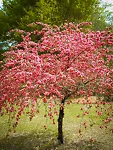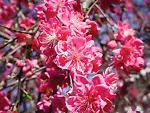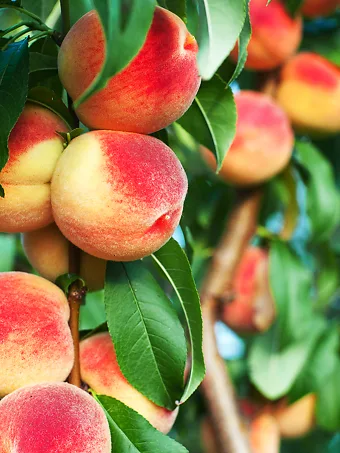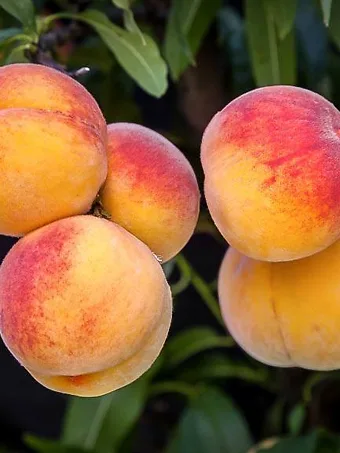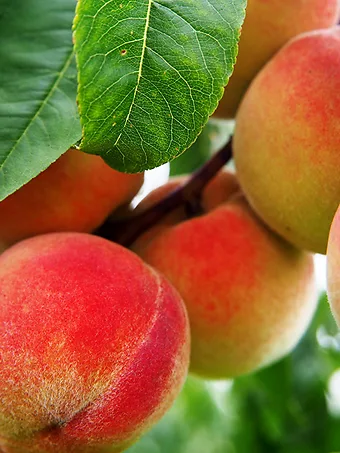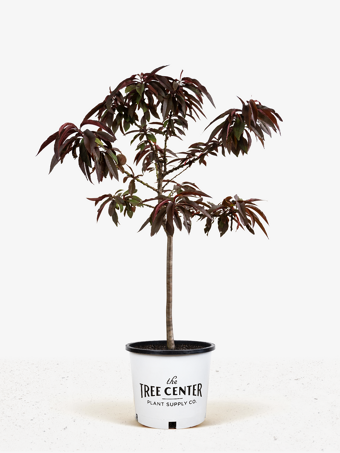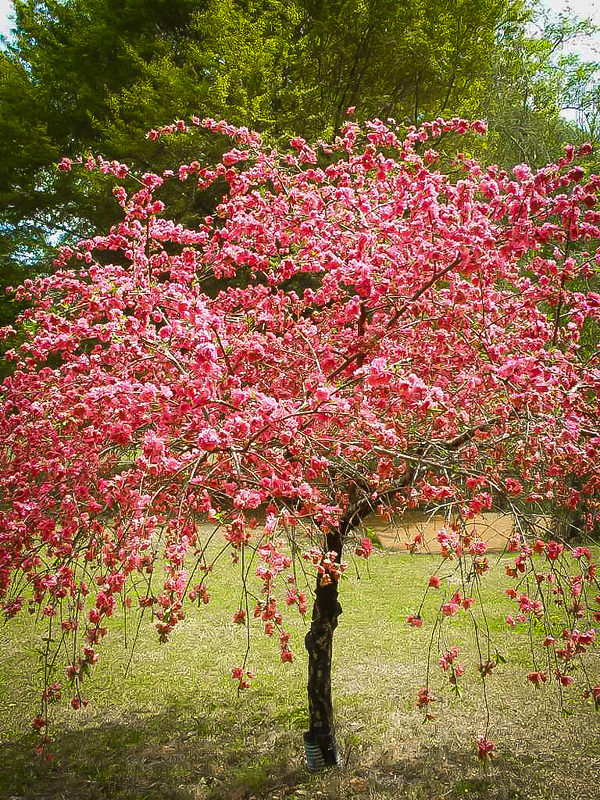
Pink Cascade Weeping Peach
Prunus persica 'Pink Cascade'View more from Peach Trees
Pink Cascade Weeping Peach
Prunus persica 'Pink Cascade'
30 day - ARRIVE AND THRIVE™ guaranteeLearn more


Special Features

Botanical Name
Prunus persica 'Pink Cascade'
Outdoor Growing zone
5-9
Mature Height
12-15
Mature Width
12-15
Sun needs
Full Sun
The Pink Cascade Weeping Peach Tree is a superb spring-flowering tree that will really brighten your garden. It has an arching and semi-cascading form, with a rounded crown that will grow to 15 feet tall and wide. In April the bare branches are smothered in rows and rows of large, double, bright pink flowers and this tree makes a gorgeous lawn specimen, or it looks perfect planted in a large garden bed. To keep things interesting after flowering, the leaves are purple-red from late spring to fall, when they turn golden yellow.
- A gorgeous arching and cascading spring-flowering tree
- Large bright pink flowers all along the bare branches
- Rounded crown to 15 feet tall and wide
- Purple-red leaves all summer
- Heat resistant and reliable
Grow the Pink Cascade Weeping Peach Tree in full sun for maximum blooming. It thrives in any well-drained soil, doing best in richer, moist soils, although once established it is relatively drought tolerant. It thrives in hot weather, and it grows well from zone 5 all the way into zone 9. It doesn’t produce fruit, so problems with diseases or pests are rarely important to the health of your tree. It can be pruned for shape in summer, removing crowded branches as needed.
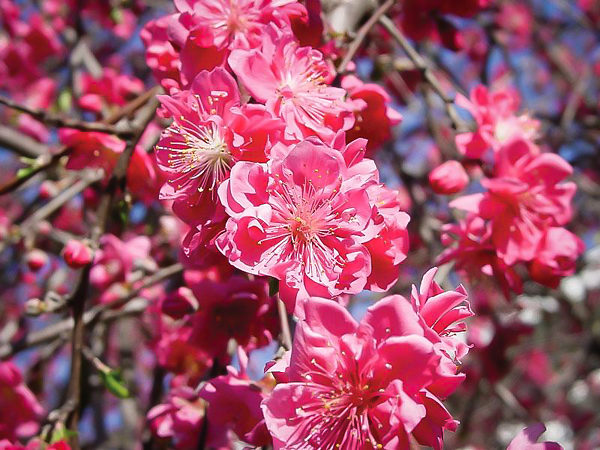
Nothing says ‘spring’ like flowering trees, and no trees bloom with such reckless abandon as peach trees do. Because the branches are leafless, the color blazes out unhidden by foliage, and the profusion of blossoms all along the branches makes a wonderful display. The colors are clean and bright, and a tree in bloom is an absolute show-stopper. When you combine all this with the grace and charm of arching and weeping branches, as we see in the amazing Pink Cascade Weeping Peach Tree, then you have a real winner for any garden. If you want your spring garden to rise to another level of beauty, plant this tree. As well, it has attractive red-purple foliage, so it adds beauty and color to your landscape all through summer too. The fall leaves are golden yellow.
Growing the Pink Cascade Weeping Peach Tree
Size and Appearance
The Pink Cascade Weeping Peach Tree is a small tree that will grow between 12 and 15 feet tall, and sometimes taller. It has a spread about equal to its height. The strong central trunk branches out into several main limbs, giving the tree a casual garden look. The broad crown spreads wide, with the branches growing upwards and outwards, but also arching over and hanging down, making a graceful and elegant crown. This is a full-sized tree, not a small grafted plant with branches that fall vertically down from the top like a waterfall.
The year begins in April with the flowering of your tree, and it is a magnificent display. All along the bare branches, clusters of blossoms open, so each stem is a continuous flow of rich pink. The flowers are a true mid-pink, with a powerful and eye-catching brightness, without being either pale and faint, or reddish. The blossoms are carried in clusters, and each flower is up to 2 inches across and semi-double, with many petals making a dense and showy bloom.
As the flowers fade the leaves emerge. These are oval, between 3 and 6 inches long, with a tapering tip and serrated edges. The spring leaves are a rich, bright red, turning darker purple as they mature. This color holds well through summer, but in the hottest areas it may become more greenish by late summer. Fall coloring is yellow with some orange. This tree normally produces no fruit, or possibly a few small dry ones. The seed is not edible like the almond, as it contains cyanic acid.
Using the Pink Cascade Weeping Peach Tree in Your Garden
This tree is an obvious specimen for a lawn, where it will look simply gorgeous. Keep a circle free of grass around it, covered with mulch or planted with flowers, to protect the trunk from string trimmers, and avoid competition for water and food with the grass. It is also lovely in a shrub bed, towards the back perhaps, or standing over a collection of smaller shrubs, particularly ones that bloom in summer and fall, to continue the display. It is also the perfect choice for a simple Zen-style courtyard, where it has exactly the right look of classic oriental style.
Hardiness
This tree is completely hardy from zone 5 to zone 9.
Sun Exposure and Soil Conditions
For the best results in bloom density and leaf color, grow your Pink Cascade Weeping Peach Tree in full sun. It will take an hour or two of shade, ideally in the afternoon, but not much. It grows well in any average well-drained soil, and although it is reasonably drought resistant once established, it benefits from watering during hot weather, and from mulch to conserve moisture, keep the roots cool and provide nutrients. It is heat tolerant, and grows well in hotter regions, like the south-east.
Maintenance and Pruning
No specific care is needed for this tree, which grows naturally into a charming and graceful shape. If you wish you can prune it in early summer (during dry weather to avoid disease risks), to create a more open or stylized crown, depending on your garden and your needs. Try to form your tree early, by removing small branches, so that you don’t have large scars from taking off bigger ones. There are some diseases that can affect peach trees, but since this tree is not being grown for fruit these will not normally cause any significant problems for you.
History and Origin of the Pink Cascade Weeping Peach Tree
The peach tree, Prunus persica, was one of the first trees grown for fruit, and it has been cultivated for thousands of years. It probably originated in China, but it spread across the world so long ago we really can’t be sure. Most trees are grown for their fruit, but over time varieties with attractive blooms have been selected to grow in gardens, for their magnificent flowering display. We don’t know the exact origin of the flowering variety called ‘Pink Cascade’, but it may be closely related (or the same as?) to a variety called ‘Windle Weeping’, which was developed by W.B. Clarke in San Jose, California, sometime before 1949. Wherever it came from, this is a very special and beautiful tree you are going to love.
Buying the Pink Cascade Weeping Peach Tree at The Tree Center
We have some great young trees available, and this tree grows fast and will soon be looking lovely in your garden. But order now, while our stock holds out, as they will all be gone very soon – beautiful trees don’t stay around our farm for long.
